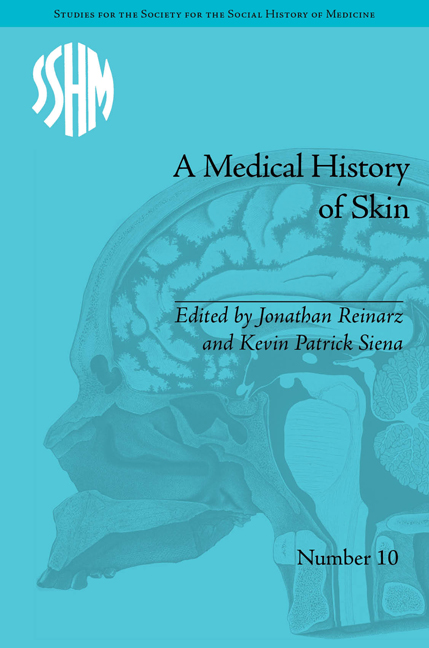Book contents
- Frontmatter
- CONTENTS
- List of Contributors
- List of Figures and Tables
- Scratching the Surface: An Introduction
- Part I The Emerging Skin Field
- 1 Drain, Blister, Bleed: Surgeons Open and Close the Skin in Georgian London
- 2 Abominable Ulcers, Open Pores and a New Tissue: Transforming the Skin in the Norwegian Countryside, 1750–1850
- 3 Protecting the Skin of the British Empire: St Paul's Bay Disease in Quebec
- 4 ‘Italic Scurvy’, ‘Pellarina’, ‘Pellagra’: Medical Reactions to a New Disease in Italy, 1770–1815
- Part II Skin, Stigma and Identity
- Part III Skin, Disease and Visual Culture
- Afterword: Reading the Skin, Discerning the Landscape: A Geo-historical Perspective of our Human Surface
- Notes
- Index
4 - ‘Italic Scurvy’, ‘Pellarina’, ‘Pellagra’: Medical Reactions to a New Disease in Italy, 1770–1815
from Part I - The Emerging Skin Field
- Frontmatter
- CONTENTS
- List of Contributors
- List of Figures and Tables
- Scratching the Surface: An Introduction
- Part I The Emerging Skin Field
- 1 Drain, Blister, Bleed: Surgeons Open and Close the Skin in Georgian London
- 2 Abominable Ulcers, Open Pores and a New Tissue: Transforming the Skin in the Norwegian Countryside, 1750–1850
- 3 Protecting the Skin of the British Empire: St Paul's Bay Disease in Quebec
- 4 ‘Italic Scurvy’, ‘Pellarina’, ‘Pellagra’: Medical Reactions to a New Disease in Italy, 1770–1815
- Part II Skin, Stigma and Identity
- Part III Skin, Disease and Visual Culture
- Afterword: Reading the Skin, Discerning the Landscape: A Geo-historical Perspective of our Human Surface
- Notes
- Index
Summary
Introduction: Padua's San Francesco Grande Hospital, 1789
In 1789, a twenty-five-year-old student doctor at Padua's hospital of San Francesco Grande reported on his first encounter with a new disease:
I came across it quite by chance in the hospital, having resumed my customary practice of going there, as the real and only source of medical observations. It so happened that one day I was present when a young sick woman was admitted. The attending physician was asking her different questions as usual, to which she replied haltingly, evidently in a daze. I happened to gaze at her hands, and saw that they were of a blackish colour, as was also part of her arms. I proceeded to examine her more carefully, and I noticed that the cuticle there was dried and rough, and that here and there it was starting to peel off, whilst the skin underneath remained white and shiny. In addition, the [woman's] mother related how an extreme weakness, particularly in her legs, had reduced the poor young woman to a state where she was incapable of performing her country labours, and how these complaints had afflicted her the past two years, at the start of the spring season. Pausing to think about the three observed phenomena, that is her dizziness, extreme weakness and especially the morbid alteration of the cuticle, I was immediately reminded of pellagra, a disease pervasive in the territory of Milan [Lombardy], and I believed there was a very great similarity to it. The attending physician, seeing me particularly attentive in the examination of this sick woman, told me that for the last few years, but especially this year, similar patients had been coming to the hospital, about whom only general ideas had been reached hitherto.
- Type
- Chapter
- Information
- A Medical History of SkinScratching the Surface, pp. 57 - 70Publisher: Pickering & ChattoFirst published in: 2014



